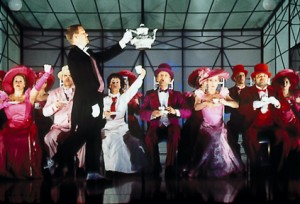“So, how’s the piece?” It’s a question I get a lot, often accompanied by a skeptical look, since I tend to work on plenty of oddball repertoire. Some people are more blunt: “Why are they doing that?” Conventional wisdom holds that if a work is infrequently performed, there’s probably a reason.
It’s funny, this hang-up we can have about scores outside of The Canon of Masterworks. It’s funny because the same people who turn their backs on a composer’s less famous efforts will flock to a retrospective that represents the highs and—well, let’s call them the not-so-highs—of a visual artist’s career, because these exhibits give us a more complete portrait of the artist. And while some works may not have the impact of others, if we love the artist, chances are there is something to love about almost everything. Certainly there is something to learn. (Performing arts organizations rarely give us the opportunity to explore a creator’s catalog in this way. One exception is Signature Theater in New York City, which dedicates each season to a single playwright. This year, they are featuring Tony Kushner, the librettist for our A Blizzard in Marblehead Neck.)
Anyway, I’ve been thinking about the masterwork hang-up lately because I just had an extraordinary experience working on Leonard Bernstein’s A Quiet Place at New York City Opera. When I started listening to it this summer, I did not immediately fall in love, though I did find it fascinating to see a new facet of this beloved composer’s work.
When it comes to unearthing unknown works, performing arts institutions are at a distinct disadvantage compared to art museums. A museum can offer curiosities simultaneously with the popular crowd-pleasers. For an opera company, not only does the rarity exclude a household name, you’re gambling with a much higher stakes. Instead of finding a few square feet of hanging space, you’re hiring a creative team and building lots of stuff to realize their vision. You’re rehearsing a huge cast and orchestra.
But this gamble is also the secret weapon. Because, finally, the success of an opera performance does not depend only on the score. Glimmerglass has been home to some of my most memorable experiences in the theater, and most of them have not been around works previously recognized as “great.”

I think of our production of Britten’s Paul Bunyan, or Thomson’s The Mother of Us All, or Handel’s Partenope, or even Sousa’s The Glass Blowers. I don’t think anyone would fall deeply in love with these pieces based on their scores alone (I sure didn’t), but those productions demonstrated that sometimes, an intriguing work + talented artists + adequate time to rehearse and explore = “Where has this opera been all my life?”
Certainly that was my experience with A Quiet Place. City Opera pulled together a terrific creative team and cast, and I’m proud that many of them have ties to Glimmerglass. Joshua Hopkins, a former member of the Young American Artists Program, gave a knockout performance as Junior. Jake Gardner has played a number of roles for us, and will return this summer as Buffalo Bill in Annie Get York Gun. But perhaps the biggest kudos for the evening goes to Christopher Alden, Andrew Lieberman, Kaye Voyce and Aaron Black, who performed the neat trick of working within a very realistic contemporary scenario while at the same time transcending it with a production as delightfully strange as the opera itself.
If I had to choose between A Quiet Place and West Side Story in assembling a collection of “desert island discs,” I’d still probably choose the latter. But if I were choosing a show to see tomorrow night, there would be no question.
Olé!
